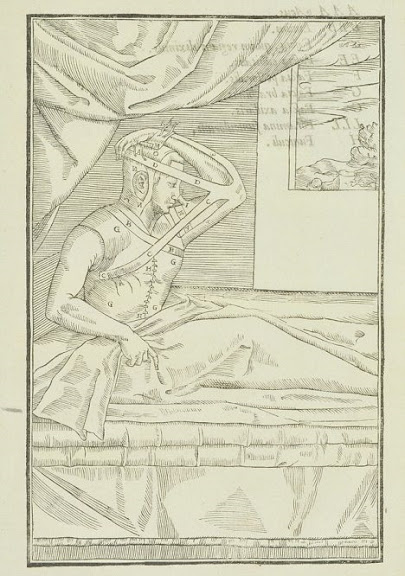The Daily Mail reports that a German manuscript has been sold, which depicts what may be the first 'plastic surgery' to rebuild an injured nose.
A 16th century book detailing one of the earliest rhinoplasty operations came to light when it was sold at auction.
The incredibly rare work, titled De Curtorum Chirurgia Per Insitionem - meaning The Surgery of Defects by Implantations - was published in 1597, and was written by Gaspare Tagliacozzi, professor of surgery and anatomy at the University of Bologna.
It describes operations carried out to repair faces that had been wounded in battle.
The tome, which is written in Latin, is illustrated with diagrams, including the rhinoplasty, in which the patient's nose was attached to a flap of skin from his upper arm.
In one plate, the patient is seen in bed with his forearm attached to his head and a flap of skin from his bicep region stuck onto his nose.
The book tells how he stayed like that for about three weeks until the skin from his arm had attached itself properly.
After a further two weeks the flap of skin was shaped so it resembled a nose and the process was complete.
The book was sold for £11,000 to a modern-day plastic surgeon.
There's more at the link.
That really amazes me! I'd never have thought that such advanced techniques were known as long ago as the 16th century, when the most advanced treatments for almost any disease or injury involved bloodletting, and the administration (as healing medication) of poisons such as arsenic and mercury! It seems that at least one doctor, in at least one place, was more advanced than his contemporaries . . . fortunately for his patients!
Peter


3 comments:
This illustration is incredibly reminiscent of the pioneering skin graft surgery done to repair the "airman's burn" pattern during WWII in England.
Nota Bene - no anesthesia!
The patient had to endure the surgery, no use of that arm, and then another surgery. With. No. Anesthesia.
I have been told, as a "fun fact", that the record time for amputation of a leg at the thigh was set during the civil war at about 40 seconds, if I recall, and still stands. Since anesthesia was developed shortly after that, the need for speed in amputations went away. The surgeon removed parts of two of his assistant's fingers during the operation.
just finished "The Time Traveller's Guide to Medieval England" chapter on medicine. There is a quote there from a 14th c. surgeon, John on Arderne, prescribing what we'd call anaesthesia - "henbane, mandragora, , hemlock, black and white poppies*, or henbane in alcohol, so the patient sleeps and 'who shall not feel whatsoever is done to him.'"
All that said....from the REST of the chapter I'm inclined to think of it as less "gosh, they were more sophisticated than we thought" than "okay... so occasionally through sheer pragmatism someone managed to get something right."
Also, medieval medicine is a prime example of "it's not that they don't know anything.... it's that they know so much that isn't so."
They had scads of medical texts and advice, built on complex medical theory.
Almost all of it wrong.
... not that we'd know anything about that today. ;)
*Poppies! Poppies! Poppies!
(get your darling wife to explain that one. :) )
Post a Comment